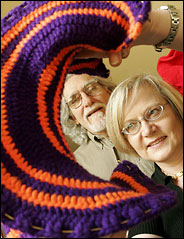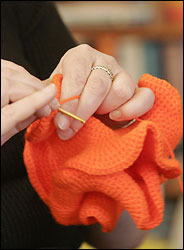
Press Archive
Professor Lets Her Fingers Do the Talking
March 13, 2005
By MICHELLE YORK
Published: July 11, 2005
ITHACA, N.Y. - Some people looking at the crocheted objects
on Daina Taimina's kitchen table would see funky modern art.
Others would see advanced geometry.
The curvy creations, made of yarn, are actually both. And they
are helping two very different groups - artists and mathematicians
- learn more about each other. Increasingly, they are also making
a quirky celebrity out of the woman who created them.
"The forms are amazing," said Binnie B. Fry, the gallery
director of the Eleven Eleven Sculpture Space, an art gallery
in Washington, where Dr. Taimina's creations are part of a summer
exhibition called "Not the Knitting You Know."
Dr. Taimina, a math researcher at Cornell University, started
crocheting the objects so her students could visualize something
called hyperbolic space, which is an advanced geometric shape
with constant negative curvature. Say what?
Well, balls and oranges, for example, have constant positive
curvature. A flat table has zero curvature. And some things,
like ruffled lettuce leaves, sea slugs and cancer cells, have
negative curvatures.
This is not some abstract - or frightening - math lesson. Hyperbolic
space is useful to many professionals - engineers, architects
and landscapers, among others. So Dr. Taimina expected some
attention for her yarn work, especially from math students destined
for those professions. But her work has recently drawn interest
from crocheting enthusiasts.
Math professors have been teaching about hyperbolic space for
decades, but did not think it was possible to create an exact
physical model. In the 1970's, some educators, including Dr.
Taimina's husband, David Henderson, a math professor at Cornell,
created hyperbolic models, but the first ones, made from paper
and cellophane tape, were too fragile to be of much use.
Though she did not realize it at the time, Dr. Taimina was a
good candidate to create a better model. As a precocious child
in her native Latvia, she tried her elementary school teacher's
patience. When her fellow second graders did not understand
a math lesson, she recalled, she would jump up and yell, "I
can't stand these idiots," prompting her teacher to send
notes home.
By high school she had settled down, and was most impressed
by a teacher who was known to keep his advanced students laughing
and engaged. When she became an educator, she decided that no
student, regardless of aptitude level, would feel out of place
in her classroom. One way she assured that was by using everyday
objects to explain theories. (She was known for peering so intently
at the oranges at her local grocery to see if she could find
perfectly round ones to use in her geometry class that she scared
the clerks.)
But it was her crocheting hobby that would prove really useful
and make her something of a star - at least to knitters and
math lovers.
In 1997, while on a camping trip with her husband, she started
crocheting a simple chain, believing that it might yield a hyperbolic
model that could be handled without losing its original shape.
She added stitches in a precise formula, keeping the yarn tight
and the stitches small. After many flicks of her crocheting
needle, out came a model.
One professor who had taught hyperbolic space for years saw
one and said, "Oh, so that's how they look," Dr. Taimina
recalled in an interview at her home here, not far from the
Cornell campus. A year after she created the models, she and
her husband gave a talk about them to mathematicians at a workshop
at Cornell. "The second day, everyone had gone to Jo-Ann
fabrics, and had yarn and crochet hooks," said Dr. Taimina.
"And these are math professors."
The crossover to the art world began last year. An official
of the Institute for Figuring, an educational organization based
in Los Angeles, spotted an article about Dr. Taimina's models
in New Scientist magazine and invited her and her husband to
California to speak about them. An audience that included artists
and movie producers was there. "They told us this helps
with their imagination," Dr. Henderson said.
In February, the two spoke in New York City. To their surprise,
the talk, at the Kitchen, a performance space in Chelsea, sold
out. Some enthusiasts asked if they were going on tour.
Gwen Blakley Kinsler, the director of the Crochet Guild of America,
believes Dr. Taimina's objects will be of interest to free-form
crocheters. "It's always nice to be validated," she
said. "People think only grannies do this and it's just
doilies."
She plans to publish an article about Dr. Taimina and her hyperbolic
creations in Crochet Fantasy magazine later this year.
That would be interesting notoriety for someone who, as a child,
was told by her teachers not to waste time in art classes. As
an adult, when terrified artists started showing up in her math
classes to fulfill their degree requirements, she signed up
for a watercolor class, thinking, "Then I will know how
they feel."
Now when students tell her they simply cannot understand math,
she pulls out one of her paintings and says, "I learned
that in three months." Then she might pull out one of her
crochet models.

Michael J. Okoniewski for The New York Times
Daina Taimina with a crocheted form she will use in class
to explain hyperbolic space. Her husband, David Henderson,
is framed in the curve.

Michael J. Okoniewski for The New York Times
Another class lesson takes shape in the hands of Daina Taimina.
